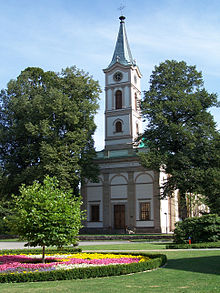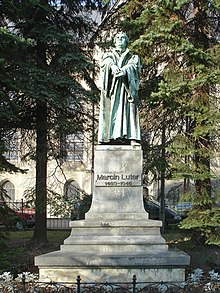Diocese of Cieszyn

The diocese of Cieszyn (in Polish Diecezja cieszyńska , formerly also seniorat śląski [seniorate of Silesia], superintendentura śląska [superintendentura Silesia], diecezja śląska [diocese of Silesia]) is the smallest of the six dioceses of the Evangelical-Augsburg Church (Luther . The official seat is Bielsko-Biała . In 2017 it counted 35,831 parishioners (out of 61,270 in Poland), thousands of other Evangelicals in Poland come from the Diocese of Teschen, especially in Upper Silesia, Cracow and Warsaw.
location
The diocese of Cieszyn comprises the area of the city of Bielsko-Biała (Bielsko-Biala) and the two districts of Bielsko (Bielitz) and Cieszyn (Teschen) in the Silesian Voivodeship . In the southwest the diocesan area extends to the border with the Czech Republic and to the historically closely related Silesian Evangelical Church of the Augsburg Confession there ; otherwise it is bounded by the Katowice diocese .
history

From Lower Silesia and Krakow which came Reformation thought of Martin Luther in the Cieszyn Silesia . In the Duchy of Teschen , the Reformation was probably not initiated by Duke Wenzel III until 1545 at the earliest . Adam introduced; only in Bielitz it was certainly earlier, at the turn of the 1530s and 1540s.
The Counter-Reformation began gradually from 1610 by Duke Adam Wenzel , then more strongly after the death of Duchess Elisabeth Lucretia under the direct government of the Habsburgs, but had no chance of exterminating the ideas of the Reformation. Although z. For example, in the minority rule Bielitz, all the churches were Roman Catholic again , but the Lutherans stayed away and held evangelical services in secret in the woods or taught in so-called "Winkelschulen" (in Bielitz).
In the treaty of 1707, Emperor Joseph I permitted the construction of six “ grace churches ” in Silesia, including one in Teschen. This church was visited by Polish, Czech (Northern Moravia) and German-speaking (e.g. from Rösnitz ) Lutherans within a radius of up to a hundred kilometers. The tolerance patent of his successor, Emperor Joseph II, enabled the revival of ecclesiastical-Protestant life in Cieszyn Silesia. At that time, the following municipalities were established until 1848: Old Bielitz , Bielitz, Ernsdorf , Bludowitz , Kameral Ellgoth , Weichsel , Bistrzitz , Ustron , Golleschau , Nawsi , Drahomischl . Altogether with Teschen 13, the largest accumulation in Cisleithanien . The Seniorate of Silesia, based in Teschen and Bielitz in the Evangelical Superintendent of A. B. Moravia and Silesia, is the predecessor institution of today's diocese of Cieszyn. Bielitz, Old Bielitz and the later community of Ober Kurzwald as well as the community in Biala, Galicia, were mostly German-speaking, Teschen and Skotschau were mixed, the rest were mostly Polish-speaking. Although the first Polish national activists Protestants ( Paweł Stalmach , Andrzej Cinciała, Andrzej Kotula), belonged before the First World War, the majority of Polish-speaking Lutherans (estimated at up to 4.3) politically for so-called schlonsakischen set, pro-German and against the Polish national movement, movement . Until 1909 the movement was gathered around the superintendent Theodor Karl Haase , after which it was formally organized as the Silesian People's Party under the leadership of Józef Kożdoń .
In 1921 there were 41,888 Protestants (almost 30% of the total population) in the Polish part of Cieszyn Silesia, 28,523 of them of Polish and 13,312 of German nationality, mainly in the Bielitz-Biala language island . In 1938 the parishes of the Silesian Evangelical Church AB were affiliated to the Superintendent of Silesia. During the Second World War it was affiliated to the Evangelical Church of the Province of Silesia as the parish of Teschen, under the leadership of the passionate supporter of fascism, Paul (Paweł) Zahradnik. The Polish language was banned in the churches and the Polish language books were destroyed. After the war, the diocese lost the German-speaking population due to the flight and expulsion of Germans from Central and Eastern Europe in 1945–1950 . The parish of Biała from the disbanded Evangelical Church of the Augsburg and Helvetic Confessions in Lesser Poland was affiliated.
In the area of the diocese, Lutherans make up 10 to 50% of the population in parishes such as Cieszyn, Skoczów, Ustroń, Goleszów, Hażlach, and in Wisła even 2/3 (it is the only town in Poland with a Protestant majority) - in predominantly Catholic Poland a special feature.
structure
The spiritual head of the diocese with its 22 parishes and 26 subsidiary parishes with 44 pastors is the bishop . The incumbent was Bishop Paweł Anweiler from 1992 to 2016 and Adrian Korczago has been since 2016 .
Together with the diocesan curator ( Adam Pastucha ), the clergy ( Jan Koziel ) and the secretary ( Józef Król ) he forms the diocesan council .
The highest decision-making body is the diocesan synod , to which all parishes send synodals (delegates). The diocese in turn is represented by synodals in the general synod of the Evangelical-Augsburg Church in Poland .
The central office of the Diocese of Teschen is at 43-300 Bielsko-Biała, pl. ks. Marcina Lutra 12.
Parishes / parishes



The following 22 parishes and 22 subsidiary parishes belong to the Diocese of Teschen:
-
Biała (Biala)
- with Salmopol and Węgierska Górka
- Bielsko (Bielitz)
- Stare Bielsko (Old Bielsko)
- Bładnice (Bladnitz)
-
Brenna-Górki
- with Górki Wielkie (Groß Gurek)
-
Cieszyn (Teschen)
- with Bażanowice , Gumna , Hażlach (Haslach) , Krasna , Marklowice (Marklowitz) , Ogrodzona (Ogrodzon) , Puńców and Zamarski (Zamarsk)
- Cisownica (Zeislowitz)
- Czechowice-Dziedzice (Chekhowitz-Dziedzitz)
- Dzięgielów (Dzingelau)
- Drogomyśl (Drahomischl)
-
Goleszów (Golleschau)
- with Godziszów (Godzischau) , Kisielów (Kieselau) , Kozakowice Dolne (Nieder Kozakotitz) and Leszna Górna (Ober Lischna)
- Istebna
-
Jaworze (Ernsdorf)
- with Jasienica (Heinzendorf) , Wapienica (Lobnitz) and Świętoszówka
-
Międzyrzecze (Short Forest)
- with Mazańcowice (Matzdorf)
- Skoczów (Skotschau)
- Ustroń (Ustron)
- Wieszczęta - Kowale
- Wisla (Vistula) - Centrum
- Wisła-Czarne
- Wisła-Głębce
- Wisła-Jawornik
- Wisła-Malinka
Facilities

- Center for Mission and Evangelism, Bielsko-Biała
- Augustana Publishing House, Bielsko-Biała
- Deaconess Mother House “Eben-Ezer”, Dzięgielów
partnership
There is a partnership between the diocese of Teschen and the An der Agger parish (seat: Gummersbach ) of the Evangelical Church in the Rhineland .
Web links
Individual evidence
- ↑ Rocznik Statystyczny Rzeczypospolitej Polskiej, Warszawa: Zakład Wydawnictw Statystycznych, 2018, ISSN 1506-0632, p. 200.
- ↑ Idzi Panic: Śląsk Cieszyński w początkach czasów nowożytnych (1528–1653) [History of the Duchy of Cieszyn at the beginning of modern times (1528–1653)] . Starostwo Powiatowe w Cieszynie, Cieszyn 2011, ISBN 978-83-926929-1-1 , p. 262-264 (Polish).
- ↑ Ewangeliccy działacze narodowi Śląska Cieszyńskiego , Cieszyn, 2018
- ↑ S. Krol: religijne Życie. In: Śląsk Cieszyński w latach 1918–1945. 2015, p. 235.
- ^ E. Pałka: Śląski Kościół Ewangelicki Augsburskiego Wyznania na Zaolziu. Od polskiej organizacji religijnej do Kościoła czeskiego. Wydawnictwo Uniwersytetu Wrocławskiego, Wrocław 2007, ISSN 0239-6661, p. 191.


